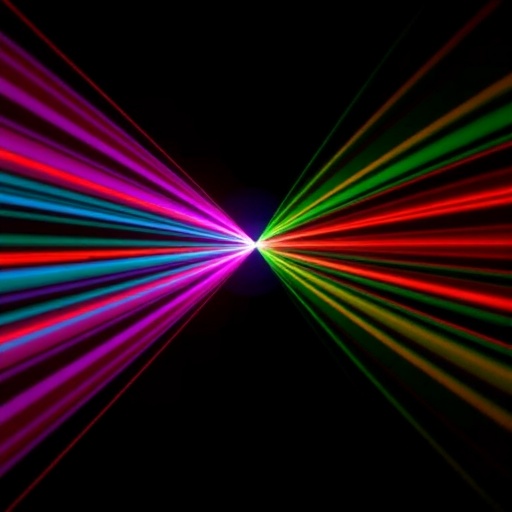In the rapidly evolving field of photonics, the precise characterization of vectorial structured light remains one of the most challenging and vital frontiers. A groundbreaking study recently published in Light: Science & Applications unveils a novel coherent detection scheme aimed at accurately quantifying the non-separability of vectorial structured light. This development heralds a significant leap forward in our capacity to probe complex optical fields, promising transformative impacts across quantum communication, optical metrology, and advanced microscopy.
Vectorial structured light—light fields characterized by spatially varying polarization states—exhibits intricate correlations between its spatial and polarization degrees of freedom. Such states cannot be described by independent spatial and polarization profiles but require a holistic framework to capture their inherent non-separability, a hallmark of their structured nature. The measurement of this non-separability is crucial for leveraging vectorial structured light in practical applications, yet traditional techniques often fall short, limited by insufficient sensitivity or indirect measurement schemes.
Addressing these challenges, the research team led by Liang, Cao, and Liu introduces an innovative coherent detection platform specifically engineered to directly quantify the non-separability of vectorial structured light. The devised detector ingeniously manipulates the light’s spatial and polarization modes, enabling a direct and precise measurement of their intertwined correlations. By integrating coherence detection with tailored spatial-polarization projections, the method circumvents the ambiguities and limitations of previous indirect approaches, paving the way for unprecedented measurement fidelity.
The core concept behind the detector is to exploit coherent interference phenomena, which are exquisitely sensitive to phase and amplitude relations among the different vectorial components of the light field. Through this interference, the non-separability metric is extracted from measured intensities and phase shifts, revealing the degree to which spatial and polarization features are entangled. This coherent detection scheme effectively deciphers the complex vectorial information embedded within structured light, providing a more robust and direct experimental observable.
An essential advantage of the new detector is its adaptability to various vectorial modes, including cylindrical vector beams and other complex polarization distributions. This flexibility ensures its utility across a broad array of photonic systems and experimental setups. Moreover, the detector operates with high accuracy and sensitivity, enabling the resolution of subtle variations in non-separability that were previously masked by noise or measurement artifacts.
The implications of this work extend far beyond mere measurement capabilities. In the realm of quantum information, the ability to precisely characterize vectorial structured light’s non-separability aids in the generation and verification of high-dimensional entanglement, a critical resource for quantum communication protocols and quantum computing architectures. The detector’s potential to systematically analyze these correlations could accelerate the development of next-generation quantum devices.
Furthermore, in advanced optical metrology and microscopy, understanding vectorial light structures with high precision enhances imaging resolutions and sensitivities. Techniques such as super-resolution microscopy and optical tweezers exploit the vectorial nature of light to manipulate matter at the nanoscale. The proposed coherent detector offers a powerful tool to optimize these applications by ensuring the exactness of the applied light fields and their interactions with target materials.
The researchers employed rigorous theoretical modeling alongside comprehensive experimental validation to substantiate their claims. They described the operational principles of the coherent detector through detailed optical simulations, demonstrating its response to various structured light inputs and comparing the outcomes with conventional measurement techniques. Subsequent laboratory experiments confirmed the theoretical predictions, showcasing consistent and repeatable detection of non-separability parameters.
Significantly, the study also highlights how the detector integrates seamlessly with existing photonic infrastructure. Its design allows straightforward implementation within standard optical setups without necessitating extensive modifications or specialized equipment. This accessibility accelerates its adoption for both fundamental research and practical applications, overcoming a common barrier faced by novel photonic measurement technologies.
An illustration accompanying the publication vividly captures the detector’s operational framework, mapping the intensity distributions of the input light and how the coherent interference yields the non-separability quantification. Such visual representations deepen the understanding of the complex interactions at play and underscore the elegance of the experimental approach.
Looking ahead, the coherent detection scheme is poised to inspire additional research avenues, including real-time monitoring of dynamic vectorial light fields and the exploration of higher-dimensional structured states. As vectorial structured light continues to emerge as a cornerstone of contemporary photonics, tools that can rigorously characterize its properties will prove indispensable.
Ultimately, the unveiling of this coherent detector stands not only as a testament to the ingenuity of modern optical science but also as a harbinger of the next wave of photonic innovations. By furnishing researchers with a direct and reliable measurement of vectorial light non-separability, it unlocks new potentialities for controlling light-matter interactions and advancing quantum-enabled technologies.
In summary, this breakthrough establishes a new standard for the measurement of vectorial structured light, addressing a longstanding obstacle in both classical and quantum photonics. Its coherent detection technique exemplifies the synergy between theoretical insight and experimental prowess, charting a course for enhanced experimentation and novel applications in the manipulation of complex light fields.
As photonics continues its trajectory toward ever more sophisticated control of light, innovations such as this will form the backbone supporting future scientific discovery and technological progress. By disentangling the complexities of vectorial light’s structure with unprecedented precision, the coherent detector signifies a pivotal step in the ongoing quest to fully harness the capabilities of structured light across diverse scientific frontiers.
Subject of Research: Coherent detection and measurement of vectorial structured light non-separability.
Article Title: Coherent detector for the non-separability measurement of vectorial structured light.
Article References:
Liang, Y., Cao, S., Liu, L. et al. Coherent detector for the non-separability measurement of vectorial structured light. Light Sci Appl 14, 343 (2025). https://doi.org/10.1038/s41377-025-02035-1
Image Credits: AI Generated
DOI: https://doi.org/10.1038/s41377-025-02035-1
Tags: advanced microscopy applicationsand Liu research teambreakthroughs in photonics technologyCaocharacterization of vectorial structured lightcoherent detection of vectorial lightdirect measurement of light correlationsinnovative photonics researchLiangmeasuring complex optical fieldsnon-separability in structured lightoptical metrology techniquesquantum communication advancementsspatial and polarization degrees of freedom





